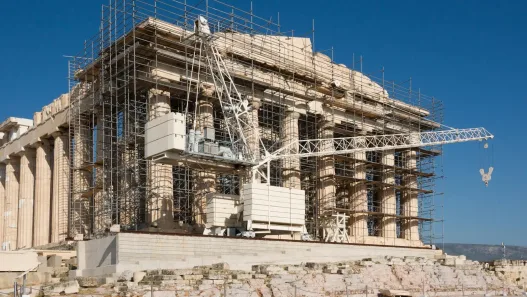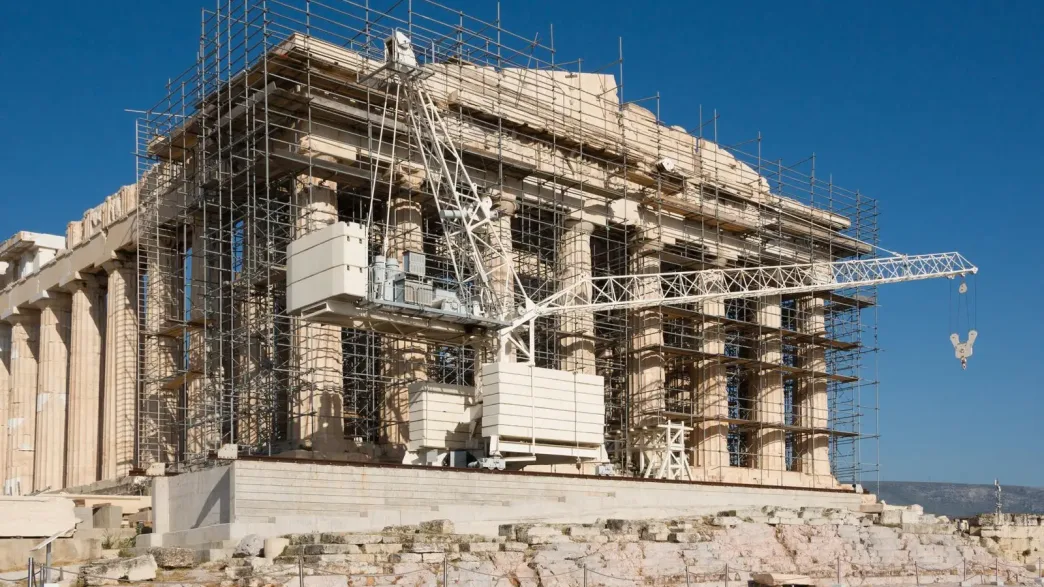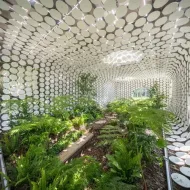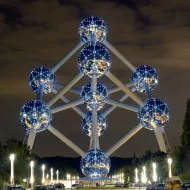Athens, the capital of Greece, stands as a living testament to the ancient world, where history and modernity intertwine seamlessly. Its architectural heritage is more than just stone and columns; it embodies the spirit of a civilization that has profoundly influenced art, philosophy and governance over the centuries. The ancient ruins scattered throughout the city serve as a bridge connecting the past to the present and inspire contemporary restoration efforts aimed at preserving this rich heritage while adapting to modern needs.
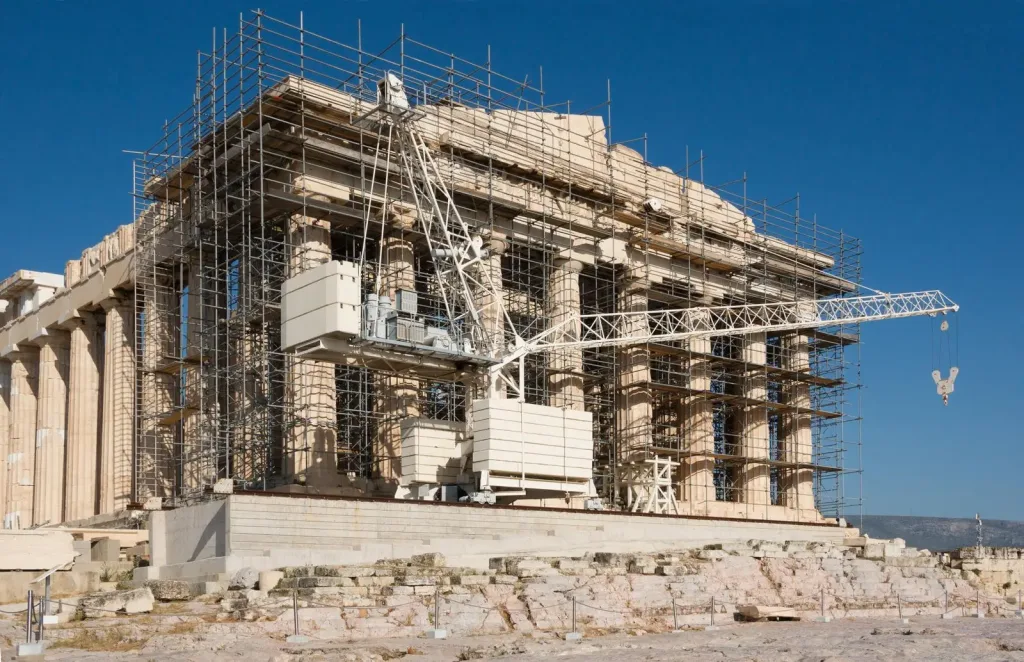
Historical Significance
Athens is of great historical importance. It was the heart of ancient Greece, a center of learning, democracy and culture. The city gave birth to influential philosophers such as Socrates, Plato and Aristotle, whose ideas continue to shape our understanding of ethics, politics and knowledge today. Architectural ruins such as the Acropolis and the Parthenon stand not only as symbols of Athenian power and art, but also as universal icons of cultural achievement. These structures remind us of a time when architectural innovation was at its peak, using advanced techniques that continue to inform modern engineering and design.
Overview of Ancient Remains
Athens is home to numerous ancient ruins that tell the story of its glorious past. The Acropolis, which towers over the city, is perhaps the most famous site, attracting millions of visitors every year. On this sacred hill are extraordinary structures such as the Parthenon, a temple dedicated to the goddess Athena, showcasing the splendor of Doric architecture. Other highlights include the Agora, the heart of public life in ancient Athens, and the Theater of Dionysus, where dramatic performances first captivated audiences. Each relic offers a glimpse into the lives of the Athenians, reflecting their values, beliefs and daily activities.
The Role of Architecture in Greek Culture
In ancient Greece, architecture was deeply intertwined with culture and spirituality. Buildings were not just functional; they were expressions of religious devotion, civic pride and artistic expression. Temples were designed to honor the gods, while public spaces such as agoras facilitated democratic discourse. The Greeks believed in beauty and proportion, which led to the development of architectural styles that prioritized harmony and balance. This commitment to aesthetic principles has left a lasting legacy, influencing countless architectural movements throughout history and inspiring contemporary designs that strive to achieve similar ideals of beauty and functionality.
Contemporary Restoration Efforts
In recent years there has been a concerted effort to restore and preserve the ancient ruins of Athens. These projects aim to preserve the integrity of the ruins while making them accessible to the public. Modern restoration techniques use advanced materials and technologies that respect the original designs while ensuring durability. For example, the Acropolis Restoration Project involves meticulous research and reconstruction using both traditional and modern methods to restore the Parthenon and other structures. These efforts not only preserve the ruins, but also promote cultural tourism, bringing economic benefits to the city and fostering a better understanding of its historical significance.
Purpose of the Blog Post
The aim of this blog post is to explore the complex relationship between the ancient ruins of Athens and contemporary restoration work. By exploring the historical significance of these sites and understanding the cultural values they represent, we can appreciate the ongoing commitment to preserving this architectural heritage. This exploration serves not only to appreciate Athens’ rich past, but also to highlight the importance of maintaining a dialogue between history and modernity in our architectural practices. As we look toward the future, Athens reminds us of the lasting impact of its ancient civilization, a legacy that continues to inform and enrich our lives today.
#Athens, Greece: Ancient Remains Inform Contemporary Restoration
Athens, the cradle of Western civilization, is a city where past and present coexist in harmony. Its rich tapestry of history is woven with threads of philosophy, art and democracy. The ancient ruins scattered throughout the city are not just relics of a bygone era; they are vital sources of inspiration and knowledge that inform contemporary restoration practice. This exploration examines the important ancient ruins of Athens and shows how they have shaped our understanding of architecture and conservation today.
Important Ancient Ruins in Athens
Acropolis
The Acropolis stands as a monumental symbol of ancient Greece, perched on a rocky outcrop overlooking the city. This UNESCO World Heritage site is a complex of buildings reflecting the artistic and architectural prowess of the ancient Greeks. The term “Acropolis” means “high city”, which is appropriate given its elevated location. For centuries, this area has been a place of worship, political activity and cultural gatherings.
The Acropolis not only showcases the creativity of ancient architects, but also serves as a focal point for contemporary restoration efforts. Ongoing restoration projects, notably the Parthenon, aim to preserve the integrity of these structures while utilizing modern techniques to ensure their longevity. By studying the original construction methods and materials, restorers can apply relevant techniques to preserve the aesthetic and historical significance of the site.
Parthenon
At the heart of the Acropolis is the Parthenon, a temple dedicated to the goddess Athena, patroness of the city. Completed in BC, this architectural masterpiece exemplifies the Doric order and demonstrates the Greek devotion to symmetry, proportion and beauty. The Parthenon was not only a religious site; it was also a symbol of Athenian democracy and power.
Today, the Parthenon continues to inspire architects and restorers around the world. Its construction methods, including the use of optical illusions to correct visual distortions, are being studied by modern architects seeking to create visually stunning structures. Ongoing efforts to restore the Parthenon emphasize the balance between preserving authenticity and adapting it to contemporary needs. Using advanced technologies such as 3D scanning, restorers can analyze the original materials and techniques and ensure that future generations can appreciate this iconic building.
Agora
The Athenian Agora was the heart of public life as a marketplace where citizens gathered to discuss politics, philosophy and everyday issues. This vibrant space was surrounded by important buildings, including temples and stoas, which served as places of social interaction and commerce. The Agora symbolizes the democratic ideals of Ancient Greece, where free citizens could exchange ideas and participate in civic life.
Modern restoration work in the Agora focuses on uncovering historical layers. The various structures, artifacts and even remnants of daily life uncovered during excavations provide insight into the social dynamics of ancient Athens. By understanding how the Agora functioned as a shared space, contemporary urban planners can learn lessons for creating inclusive public spaces that encourage dialogue and civic engagement.
Temple of Olympian Zeus
Once one of the largest temples in the ancient world, the Temple of Olympian Zeus was dedicated to the king of the gods. Construction began in the 6th century BC but was not completed until the 2nd century AD. This majestic structure with its massive Corinthian columns exemplifies the ambition of Athenian architecture.
The restoration of the temple has been a complex process given the extensive damage it has suffered over the centuries. The efforts to stabilize and preserve the remaining columns reflect a commitment to honoring the past while addressing the challenges of modern conservation. The Temple of Olympian Zeus is a reminder of the importance of historical continuity and the need for careful management of cultural heritage.
Ancient Theater of Dionysus
Located on the southern slope of the Acropolis, the Ancient Theater of Dionysus is often considered the birthplace of Western theater. Dating back to the 6th century BC, it has hosted performances by great playwrights such as Sophocles and Euripides. Its design, which can accommodate thousands of spectators, reflects the importance of the theater in Athenian society.
Today, the theater is a site of archaeological study and cultural activity, showcasing the enduring legacy of ancient Greek theater. Restoration projects focus on preserving the structure while allowing modern performances to take place. By examining the acoustics and layout of the theater, contemporary designers can create spaces that honor the past while enhancing the audience experience.
Ultimately, the ancient ruins of Athens are not just relics of history; they are living classrooms that inform contemporary architectural practice and restoration efforts. By studying these iconic structures, we gain insight into the values and innovations of ancient civilizations and can create a dialogue between the past and the present. Every ruin tells a story, and as we work to preserve them, we ensure that these stories continue to inspire future generations.
# Athens, Greece: Ancient Ruins Inform Contemporary Restoration
Athens, the cradle of Western civilization, is a city rich in history and architectural wonders. Its ancient ruins offer a glimpse into an era when architecture was not only about aesthetics, but also about expressing cultural values and social structures. Today, these ancient styles continue to inspire contemporary restoration efforts, blending the wisdom of the past with modern sensibilities.
Architectural Styles of Ancient Greece
The architectural styles of Ancient Greece form the basis of Western architecture. Each style or “order” has unique characteristics that reflect the values and aesthetics of the society that created them. Understanding these styles not only illuminates Greek history, but also shows their lasting influence on global architecture.
Doric Order
The Doric order is the oldest and simplest of the three classical styles. Characterized by its sturdy, fluted columns and flat capitals, the Doric order represents strength and masculinity. Its design often evokes a sense of stability and permanence, making it a popular choice for temples and public buildings. The Parthenon, dedicated to the goddess Athena, is a prime example of this order, displaying the Greeks’ mastery of proportion and harmony. The simplicity of the Doric columns stands in stark contrast to the elaborate ornamentation of later styles and reflects a philosophical belief in the beauty of form following function.
Ionic Order
The Ionic order, which emerged later than the Doric order, is known for its elegance and refinement. The columns are taller and thinner, with prominent parchment-like volutes on the capitals. This style often conveys a sense of femininity and refinement and was a favored choice for temples dedicated to goddesses such as Athena and Artemis. The Erechtheion, with its famous Caryatids, exemplifies the intricate detailing and emphasis on aesthetics of the Ionic style. The Ionic order represents a shift in architectural thinking and embraces not only practicality but also beauty in design.
Corinthian Order
The Corinthian order is the most ornate of the three orders developed later in Greek history. History. Its slender columns are decorated with elaborate acanthus leaves and floral motifs, symbolizing luxury and splendor. The Corinthian style became especially popular during the Hellenistic period and later in Roman architecture. The Temple of Olympian Zeus in Athens showcases the richness of this order and reflects a society that valued not only power but also art. The intricate designs of the Corinthian order have inspired countless buildings throughout history, demonstrating the Greeks’ ability to combine elaborate decoration with structural integrity.
Influence on Modern Architecture
The architectural styles of Ancient Greece have profoundly influenced modern architecture worldwide. Elements of the Doric, Ionic and Corinthian orders can be seen in numerous government buildings, museums and monuments around the world. The United States Capitol and the British Museum, for example, draw inspiration from these ancient designs, using columns to express authority and permanence. Modern architects often incorporate these classical elements into their work, blending them with contemporary materials and techniques to create buildings of historical significance while serving modern needs.
Symbolism in Design
Greek architecture is rich in symbolism and reflects the values and beliefs of its time. Each order not only serves as a functional element, but also carries deeper meanings. Sturdy Doric columns symbolize strength and stability, while graceful Ionic columns represent beauty and harmony. Ornate Corinthian columns, with their lush ornamentation, evoke a sense of splendor and divine connection. This interplay of form and meaning emphasizes the Greek understanding of architecture as a language that communicates cultural identity and social values. Architects today continue to draw on this symbolism, using design to express themes such as sustainability, community and innovation.
In sum, the architectural styles of Ancient Greece are not just relics of the past; they are living elements that continue to inform and inspire contemporary design. By studying these styles, we gain insight into the cultural and philosophical underpinnings of ancient Greece, while also recognizing their relevance to today’s architectural landscape. The ruins of Athens are a reminder of our shared history and the enduring legacy of human creativity.
#Athens, Greece: Ancient Remains Inform Contemporary Restoration
A city steeped in history, Athens serves as a living museum where ancient ruins bear witness to a glorious past. The Parthenon, the Agora and countless other structures tell stories of ancient civilization and art. As these monuments age, the challenge of preserving their integrity for future generations becomes paramount. Contemporary restoration techniques play an important role in ensuring that these historical treasures are preserved while respecting their original essence.
Contemporary Restoration Techniques
The field of restoration has evolved significantly, blending traditional craftsmanship with modern techniques. Each project is a delicate dance between preserving authenticity and adapting to contemporary needs. Modern restorers draw on a wealth of knowledge and technology to ensure that the stories these structures tell remain alive and intact.
Materials Used in Restoration
When it comes to the restoration of ancient ruins, the choice of materials is critical. Restorers often choose materials that are compatible with the original in order to maintain aesthetic and structural integrity. For example, limestone and marble, commonly used in ancient Greek architecture, are often sourced from nearby quarries to ensure a perfect match. Innovative materials are also used, such as breathable lime mortars that allow moisture to escape without damaging the underlying stone, reflecting a deep understanding of the original construction techniques. This careful selection helps create a seamless blend between old and new, keeping the historical narrative alive.
Conservation and Restoration
The distinction between conservation and restoration is vital in the context of ancient ruins. Conservation focuses on preserving a building in its current state, preventing further deterioration without altering its original form. Restoration, on the other hand, aims to restore a building to its former glory, often involving repair and reconstruction. In Athens, this debate often arises, especially when it comes to iconic monuments such as the Parthenon. The decision to restore or preserve a building can lead to intense debate among architects, historians and the public, each emphasizing different values in the management of cultural heritage.
The Role of Technology in Restoration
Technology is playing an increasingly important role in the restoration of ancient sites. Advanced imaging techniques such as 3D laser scanning allow restorers to create precise models of structures, facilitating detailed analysis and planning. These models help identify areas that need attention and can simulate environmental impacts over time. Furthermore, the use of unmanned aerial vehicles allows for aerial imaging of areas that were previously difficult to survey. By integrating technology into restoration practices, professionals can make informed decisions that enhance both the safety and authenticity of structures.
Case Studies of Successful Restorations
Several restoration projects in Athens exemplify the successful application of contemporary techniques. A notable example is the restoration of the Acropolis Museum, which harmoniously blends modern architecture with the ancient ruins it houses. The museum was designed to enhance the visitor experience while preserving the integrity of the archaeological site. In addition, the ongoing restoration of the Parthenon uses advanced scientific methods to stabilize the structure and repair damage caused by pollution and past restoration attempts. These case studies illustrate how contemporary practices can breathe new life into historic ruins and honor their historical significance.
Challenges in Restoration Projects
Despite advances in restoration techniques, numerous challenges remain. One of the most important issues is financing; restoration projects often require significant investments and securing financial resources can be difficult. In addition, political factors and public opinion can influence the direction of restoration work and lead to tensions between different stakeholders. Environmental conditions such as pollution and climate change also pose serious threats to the longevity of these ancient buildings. Overcoming these challenges requires a collaborative effort between architects, historians and the community to ensure that Athens’ heritage is preserved for future generations.
All in all, the restoration of Athens’ ancient ruins is a complex but fascinating endeavor. By skillfully blending traditional methods with contemporary techniques, the restorers not only preserve the physical structures, but also the cultural narratives they embody. Each project reflects a commitment to history, innovation and a shared responsibility to preserve our common heritage. Looking to the future, the lessons learned from these restoration efforts will undoubtedly guide how we approach the preservation of architectural treasures around the world.
# Athens, Greece: Ancient Remains Inform Contemporary Restoration
A city steeped in history, Athens is home to some of the world’s most remarkable ancient ruins. From the majestic Parthenon to the ancient Agora, these structures are not just relics of the past; they provide a foundation for contemporary restoration efforts. As tourism continues to flourish in this vibrant city, it brings both opportunities and challenges for the preservation of architectural heritage. This research examines the profound impact of tourism on restoration efforts in Athens.
The Impact of Tourism on Restoration Efforts
Tourism is a double-edged sword for historically rich cities like Athens. While it provides the necessary funding and visibility for restoration projects, it also presents significant challenges. The influx of visitors can lead to the wear and tear of ancient sites, creating a delicate balance between making these treasures accessible and ensuring their long-term preservation.
Economic Benefits of Tourism
Tourism is one of the cornerstones of Athens’ economy. The income from millions of visitors each year contributes significantly to local businesses, from restaurants to souvenir shops. This economic boost allows the government and various organizations to allocate more funds for the restoration and preservation of historic sites. For example, ticket sales from the Acropolis alone help fund ongoing maintenance and restoration projects, ensuring that these treasures remain intact for future generations to enjoy.
Balancing Conservation and Accessibility
As the number of tourists increases, so does the pressure on Athens’ ancient buildings. Restoration work must consider not only the physical integrity of these sites, but also how to keep them accessible to visitors. This challenge was evident during the restoration of the Parthenon, where careful planning was necessary to allow public access while taking protective measures to preserve the structure. Strategies to manage visitor flows, such as timed entry tickets and guided tours, have shown that it is possible to balance conservation with accessibility.
Visitor Experience and Education
Tourism is not only about economic gain; it also offers a unique opportunity for education. When visitors come to Athens, they are not just looking at ruins; they are immersed in history. Restoration efforts often include educational components, such as information plaques and guided tours explaining the significance of each site. For example, the Acropolis Museum provides context and artifacts that enrich the visitor experience, enabling tourists to appreciate the depth of Athens’ history while fostering a sense of stewardship for these ancient treasures.
Sustainable Tourism Practices
Sustainability has become a critical focus for Athens within the complexity of tourism. Restoration projects increasingly emphasize eco-friendly practices that minimize environmental impact. This includes using sustainable materials in restoration work and promoting alternative tourism routes that divert traffic away from the most popular areas. Such initiatives not only preserve the ruins, but also enhance the overall visitor experience by encouraging the exploration of lesser-known areas, thus distributing the economic benefits of tourism more evenly across the city.
The Future of Tourism in Athens
Looking ahead, the future of tourism in Athens will likely depend on how well the city can adapt to changing dynamics. With a growing awareness of conservation and sustainability, Athens is poised to redefine its relationship with tourism. Emphasizing responsible tourism practices, improved visitor education and ongoing restoration work will be vital to ensure that Athens remains a vibrant, living museum for future generations. By fostering a culture that values both its rich history and the sustainability of its spaces, Athens can continue to be a beacon of ancient civilization in a modern world.
Ultimately, the interplay between tourism and restoration in Athens is an engaging narrative of opportunity, challenge and resilience. As the city embraces its role as a historical destination, it is also committed to preserving its ancient treasures for future discovery and appreciation. The lessons learned in Athens can serve as a model for other cities grappling with similar issues in the protection of their cultural heritage.
# Athens, Greece: Ancient Remains Inform Contemporary Restoration
Conclusion The Future of Athenian Architecture
Turning our gaze to the future of Athenian architecture, we find ourselves at a remarkable intersection of history and modernity. With its rich tapestry of ancient ruins, Athens has long been at the vanguard of architectural innovation, inspiring generations of builders and thinkers. The legacy of structures such as the Parthenon and the Agora continues to inform contemporary practice, prompting us to consider not only what we build, but how we honor the past in our designs.
The Legacy of Ancient Architecture
The ancient architecture of Athens is not just stone and mortar; it embodies the values, beliefs and aspirations of a civilization that profoundly shaped Western culture. Classical principles such as symmetry, proportion and harmony remain central to modern architectural discourse. Even today, when architects design new buildings, they often draw on the timeless elegance of Ancient Greek design. This legacy is a reminder that architecture is not only functional, but also a form of storytelling, where each building tells parts of the human experience.
Ongoing Restoration Projects
Athens is a living museum where restoration projects are constantly underway to preserve its historical treasures. The Acropolis Restoration Project is a prime example, aiming to stabilize and restore the Parthenon using techniques that respect the original workmanship. These efforts not only preserve the monuments for future generations, but also provide valuable insights into ancient construction methods. As modern technologies are integrated into these projects, we are witnessing a fascinating blend of past and present that allows ancient ruins to remain accessible and relevant in today’s world.
Impact on Future Architectural Designs
The influence of Athenian architecture transcends the borders of Greece, inspiring architects around the world. The principles established in ancient Athens can be seen in contemporary designs that prioritize sustainability, community engagement and aesthetic beauty. For example, many modern buildings incorporate open spaces and natural light, reflecting the ancient Greeks’ understanding of the relationship between architecture and the environment. As urban areas grow and develop, the lessons from Athens remind us of the importance of creating spaces that promote connectivity and reflect cultural heritage.
The Role of Community in Conservation
The preservation of Athens’ architectural heritage is not only the responsibility of historians and architects; it requires the active participation of the community. Local residents, cultural organizations and educational institutions play a vital role in advocating for preservation efforts and raising awareness about the importance of these buildings. Community-driven initiatives encourage public participation and foster a sense of ownership and pride in the city’s rich history. When people feel connected to their environment, they are more likely to support efforts to preserve its legacy.
Final Thoughts on Athens’ Architectural Journey
As we reflect on the architectural journey of Athens, we recognize that the city stands as both a testament to human ingenuity and a canvas for future possibilities. Ancient ruins are enduring symbols of the past, but also inspirations for innovation and collaboration today. The future of Athenian architecture lies in our ability to blend respect for history with a vision of sustainable growth. By honoring the lessons of ancient Greece, we can build a vibrant architectural narrative that continues to evolve and ensure that Athens remains a source of inspiration for generations to come.
Discover more from Dök Architecture
Subscribe to get the latest posts sent to your email.








